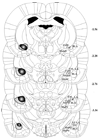Disruption of neuroendocrine stress responses to acute ferret odor by medial, but not central amygdala lesions in rats
- PMID: 19615352
- PMCID: PMC2753207
- DOI: 10.1016/j.brainres.2009.07.011
Disruption of neuroendocrine stress responses to acute ferret odor by medial, but not central amygdala lesions in rats
Abstract
Investigations of the neural pathways associated with responses to predators have implicated the medial amygdala (MeA) as an important region involved in defensive behaviors. To our knowledge, however, the involvement of the MeA in neuroendocrine responses to predator odor exposure has not been investigated. Therefore, the present study examined the effects of MeA disruption in rats exposed to ferret or control odor on hypothalamo-pituitary-adrenocortical (HPA) axis activation. Bilateral lesions of the MeA were made in Sprague-Dawley rats with the neurotoxin ibotenic acid (10 microg/microl; 0.3 microl / side). As a control for regional specificity, additional groups of rats were given lesions in the central amygdala (CeA). One week after recovery, the rats were exposed to ferret or strawberry control towels in small cages to examine HPA axis responses as determined by plasma corticosterone and adrenocorticotropin hormone (ACTH) levels. Rats with complete bilateral MeA but not CeA lesions displayed significantly less corticosterone and ACTH release compared to sham-operated control rats only in the ferret odor conditions. These results suggest that the MeA is an important structure involved in the HPA axis responses to predator odors, in support of previous studies investigating behavioral responses under similar conditions.
Figures





Similar articles
-
The medial amygdala modulates body weight but not neuroendocrine responses to chronic stress.J Neuroendocrinol. 2010 Jan;22(1):13-23. doi: 10.1111/j.1365-2826.2009.01933.x. Epub 2009 Nov 14. J Neuroendocrinol. 2010. PMID: 19912476
-
Accessory and main olfactory systems influences on predator odor-induced behavioral and endocrine stress responses in rats.Behav Brain Res. 2010 Feb 11;207(1):70-7. doi: 10.1016/j.bbr.2009.09.038. Epub 2009 Oct 1. Behav Brain Res. 2010. PMID: 19800371 Free PMC article.
-
Non-associative defensive responses of rats to ferret odor.Physiol Behav. 2006 Jan 30;87(1):72-81. doi: 10.1016/j.physbeh.2005.08.044. Epub 2005 Sep 23. Physiol Behav. 2006. PMID: 16183085 Free PMC article.
-
Selective contributions of the medial preoptic nucleus to testosterone-dependant regulation of the paraventricular nucleus of the hypothalamus and the HPA axis.Am J Physiol Regul Integr Comp Physiol. 2008 Oct;295(4):R1020-30. doi: 10.1152/ajpregu.90389.2008. Epub 2008 Aug 6. Am J Physiol Regul Integr Comp Physiol. 2008. PMID: 18685071
-
"Green odor" inhalation by rats down-regulates stress-induced increases in Fos expression in stress-related forebrain regions.Neurosci Res. 2009 Oct;65(2):166-74. doi: 10.1016/j.neures.2009.06.012. Epub 2009 Jun 27. Neurosci Res. 2009. PMID: 19563846
Cited by
-
N6-methyladenine is an epigenetic marker of mammalian early life stress.Sci Rep. 2017 Dec 22;7(1):18078. doi: 10.1038/s41598-017-18414-7. Sci Rep. 2017. PMID: 29273787 Free PMC article.
-
Stress-induced glucocorticoid desensitizes adrenoreceptors to gate the neuroendocrine response to somatic stress in male mice.Cell Rep. 2022 Oct 18;41(3):111509. doi: 10.1016/j.celrep.2022.111509. Cell Rep. 2022. PMID: 36261014 Free PMC article.
-
The role of the medial and central amygdala in stress-induced suppression of pulsatile LH secretion in female rats.Endocrinology. 2011 Feb;152(2):545-55. doi: 10.1210/en.2010-1003. Epub 2010 Dec 15. Endocrinology. 2011. PMID: 21159851 Free PMC article.
-
Comparison of the activation of somatostatin- and neuropeptide Y-containing neuronal populations of the rat amygdala following two different anxiogenic stressors.Exp Neurol. 2012 Nov;238(1):52-63. doi: 10.1016/j.expneurol.2012.08.002. Epub 2012 Aug 17. Exp Neurol. 2012. PMID: 22917777 Free PMC article.
-
The Neurological Ecology of Fear: Insights Neuroscientists and Ecologists Have to Offer one Another.Front Behav Neurosci. 2011 Apr 25;4:21. doi: 10.3389/fnbeh.2011.00021. eCollection 2010. Front Behav Neurosci. 2011. PMID: 21629856 Free PMC article.
References
-
- Adamec R. Transmitter systems involved in neuroplasticity underlying increased anxiety and defense following traumatic stress. Neurosci Biobehav Rev. 1997;21:755–765. - PubMed
-
- Adamec R, Kent P, Anisman H, Shallow T, Merali Z. Neural plasticity, neuropeptides and anxiety in animals: implications for understanding and treating affective disorder following traumatic stress in humans. Neurosci Biobehav Rev. 1998;23:301–318. - PubMed
-
- Adamec R, Muir C, Grimes M, Pearcey K. Involvement of noradrenergic and corticoid receptors in the consolidation of the lasting anxiogenic effects of predator stress. Behav Brain Res. 2007;179:192–207. - PubMed
-
- Anisman H, Lu ZW, Song C, Kent P, McIntyre DC, Merali Z. Influence of psychogenic and neurogenic stressors on endocrine and immune activity: differential effects in fast and slow seizing rat strains. Brain Behav Immun. 1997;11:63–74. - PubMed
-
- Blanchard RJ, Blanchard DC. Effects of hippocampal lesions on the rat’s reaction to a cat. J Comp Physiol Psychol. 1972;78:77–82. - PubMed
Publication types
MeSH terms
Substances
Grants and funding
LinkOut - more resources
Full Text Sources
Medical
Research Materials

